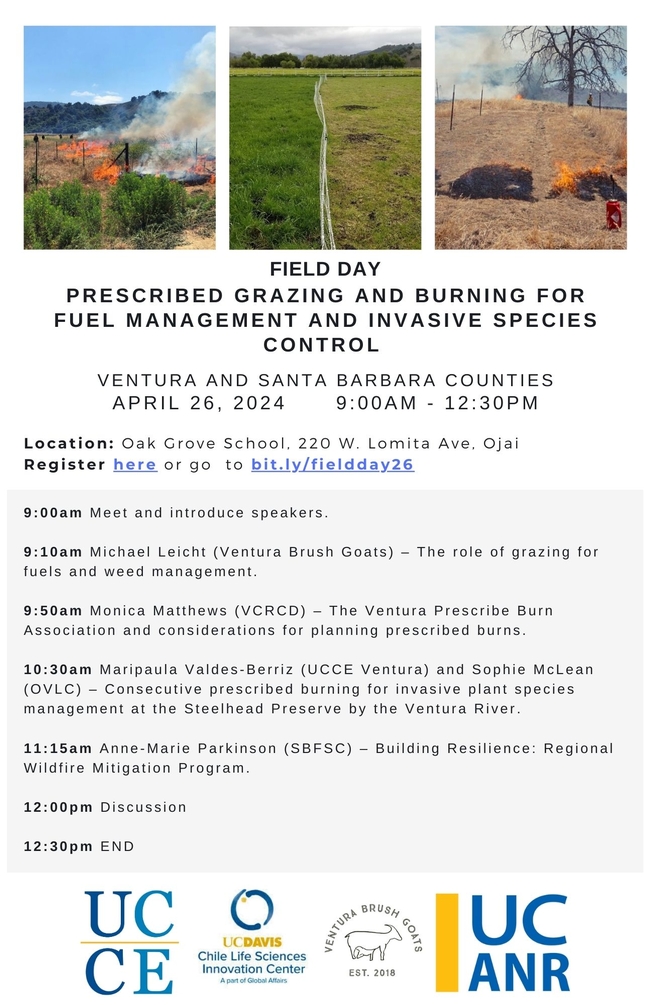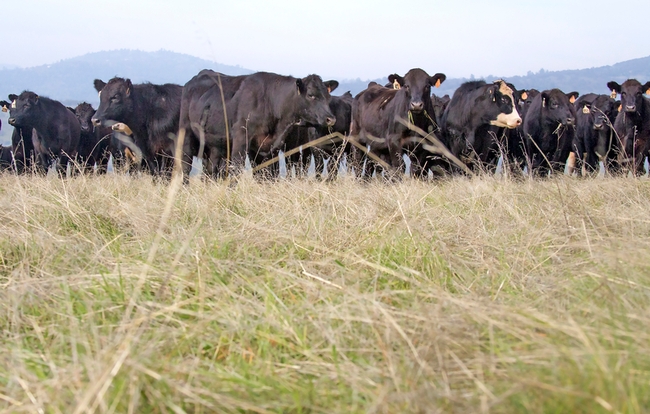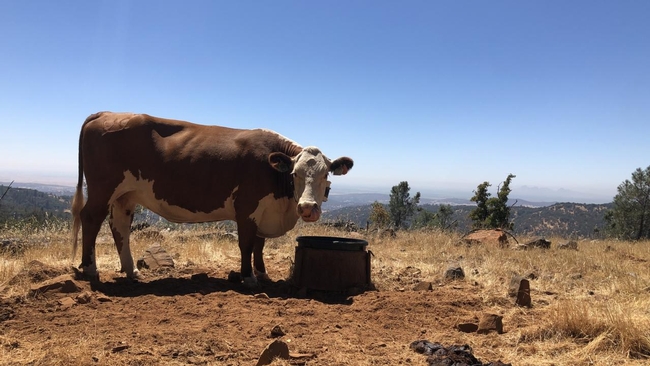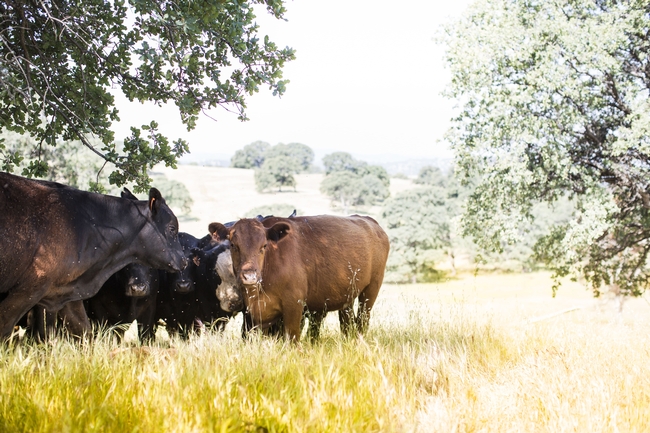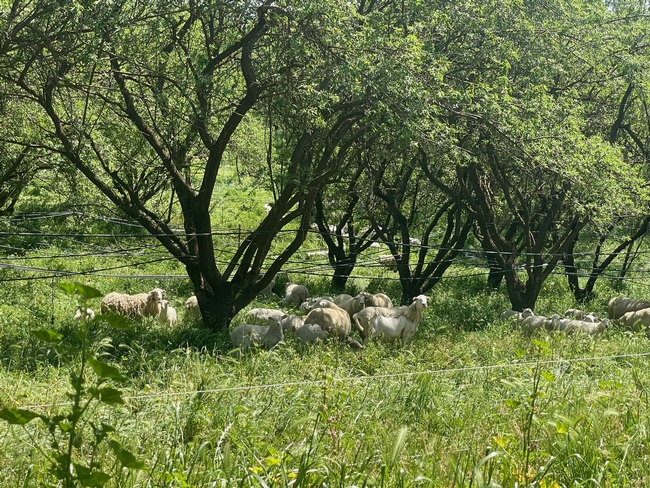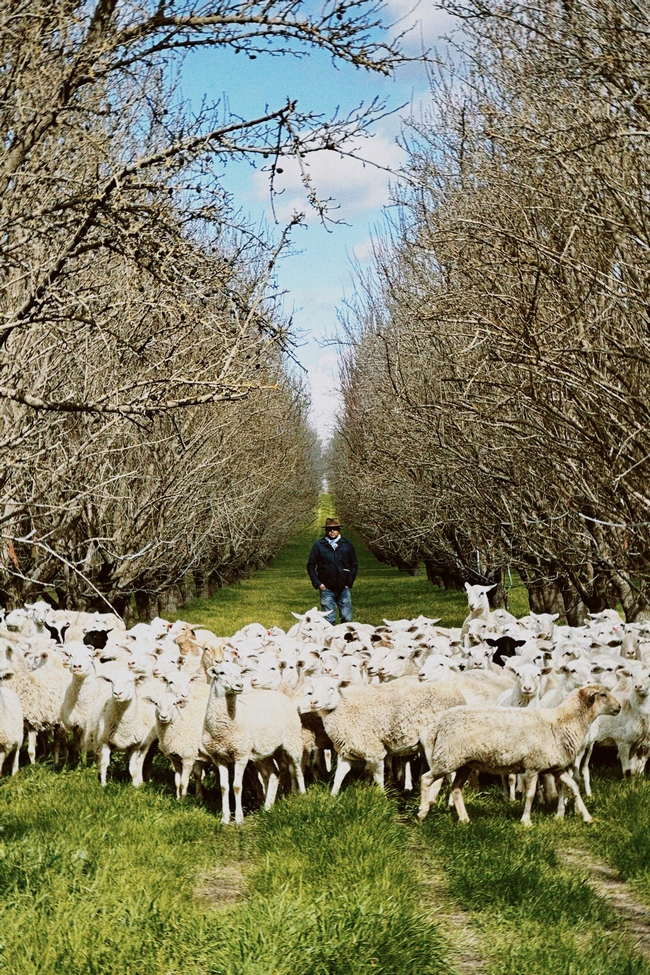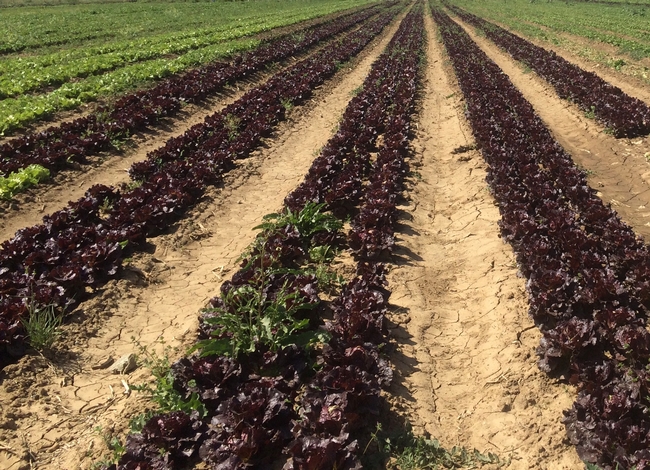Posts Tagged: grazing
Lawn-pocalypse! Surviving Drought
Ah, summer! The season of sunburns, pool parties, and… lawn droughts. If your once lush, green carpet now looks like a crunchy brown doormat, you're not alone. Let's dive into why your yard is staging a dramatic death scene and what you can do to...

Bermuda grass and weeds overtaking drought stressed turf grass.
Using Fire as a Management Tool, Prescribed Grazing Too
Understanding cattle grazing personalities may foster sustainable rangelands
Matching herds to landscape can support animal growth and ecological needs
Not all cattle are the same when it comes to grazing. Some like to wander while others prefer to stay close to water and rest areas.
Recognizing those personality differences could help ranchers select herds that best meet grazing needs on rangelands, leading to better animal health and environmental conditions, according to a new paper from the University of California, Davis, published in the journal Applied Animal Behaviour Science.
“Cattle can actually be beneficial for the rangelands,” said lead author Maggie Creamer, who recently earned her Ph.D. in animal behavior at UC Davis. “Vegetation in rangelands actually need these kinds of disturbances like grazing.”
Ranchers can add elements to the rangeland such as water, mineral supplements and fencing to influence where cattle graze, but little research has been done on how those efforts affect individual cows. Considering personalities could save money.
“If you're spending all this money to add a management tool in order to change the distribution of your animals, that's a huge cost to ranchers,” said Creamer. “Thinking about other tools, or selecting certain animals with these grazing traits, might be a better way to optimize the distribution on rangeland rather than spending a bunch of money for something that may ultimately not pan out for all your animals.”
Effects of grazing
Livestock graze on an estimated 56 million acres in California, and healthy rangelands host native vegetation and animals, foster nutrient cycling and support carbon sequestration.
Uneven grazing can degrade water quality, soil health and habitats. Optimizing grazing — including the even spread of cow pies — can improve the ecosystem while also reducing fuel loads for wildfires.
To better understand individual grazing patterns, researchers went to the UC Sierra Foothill Research and Extension Center in Browns Valley and tracked 50 pregnant Angus and Hereford beef cows fitted with GPS collars.
The research
The cattle, which were tracked from June to August over two years, had access to 625 acres of grasslands and treed areas ranging in elevation from 600 to 2,028 feet. In the second year, a new watering site was added at a higher elevation.
Across the two years, the cows showed consistent and distinct grazing patterns even when water sources changed. Age and stage of pregnancy did not affect patterns, though cattle tended to clump near water and rest sites on hotter days.
The cows that ventured into higher elevations and farther from watering sites had more variability in their grazing patterns than those that stayed at lower elevations near water. That suggests it may be harder for non-wanderers to adjust to some landscapes.
“Thinking about the topography of your rangeland and your herd of cows can benefit both the animals and the sustainability of the land,” said Creamer, who next month begins work as a postdoctoral scholar in North Carolina.
Gauging personalities
Keying in on personality type may sound difficult, but the researchers also found some clues as to how to pinpoint the wanderers and homebodies. Unlike cattle at feedlots, the breeding cow population, especially on rangelands in California and other western states, live largely “wild” lives and are rarely handled, save for vaccinations and weaning.
Research due to be published later this year found that paying attention to individual cow reactions during those events can help determine personalities. The cows that appeared more passive during those handling interactions tended to be nomadic.
“We found that you can maybe predict those hill climbers if you kind of look at how they act when the veterinarian or rancher handle them,” said senior author Kristina Horback, an associate professor in the Department of Animal Science at UC Davis.
Informing practices
For ranchers, the findings could be invaluable, said Dan Macon, a livestock and natural resources Cooperative Extension advisor in Placer and Nevada counties for UC Agriculture and Natural Resources.
“Any time we can improve our understanding of cattle behavior, particularly at the individual level, it can improve how we handle livestock and manage the landscape,” he said.
Macon said that during the recent drought, it was hard to get cattle into higher country, but if ranchers could have selected the nomads, it may have saved money in terms of ranch labor and other efforts.
“If you ask a rancher who has been attentive to their cattle over many years, they know the personalities,” Macon said.
For Creamer and Horback, the research opens new doors into understanding herd behavior and dynamics, one that could be a cheaper alternative to high-tech solutions.
“Animal science tends to look overlook the mind of the animal when searching for solutions to challenges,” Horback said. “It's always been a direct line to genetics for immunity or nutrition, but nothing about the mind of the animal. And that's such a loss. There's so much we can learn from behavior in the end.”
The Russell L. Rustici Rangeland and Cattle Research Endowment supported the research.
This article was first published on the UC Davis News site.
Fighting fire with feeding
Are cattle a secret weapon for taking on California wildfires?
California's cattle ranchers contribute a significant amount to the region's culture, economy and food supply, but do they also inadvertently help to temper the wildfires that have been plaguing the state? And if so, is it a better alternative – environmentally speaking – to letting grasslands burn?
A new study published in the journal Sustainability delves into the topic, weighing the advantages – and disadvantages – grazing cattle bring to the table. Researchers, including scientists from University of California, Davis and UC Agriculture and Natural Resources, set out to calculate the greenhouse gas emissions of cows consuming vegetation that would otherwise burn in wildfires. Then they estimated the GHG emissions that would result should that forage be untouched and therefore, consumed by fire, eventually comparing the two.
Feeling the burn
Given the severity of California's recent wildfires and the belief they will continue and even escalate in the near future, it's a discussion worth having, said Frank Mitloehner, an expert in animal agriculture and air quality from UC Davis, director of the CLEAR Center and one of the researchers who contributed to the peer-reviewed article.
“Each year from 2010 to 2020, California lost on average 89,000 acres of grassland to wildfires,” said Mitloehner, who is also a Cooperative Extension specialist. “In addition to the obvious disruption and devastation they caused, the fires spewed greenhouse gases and harmful particulate matter such as black carbon into the air and into our atmosphere. Those alone threaten climate health and human well-being.”
A fast and furious gas
Cattle are adept at eliminating herbaceous fuel as they graze. However, at the same time, their specialized digestive system produces methane that is expelled most often in the form of enteric emissions … more commonly known as belches. By way of background, methane is a potent greenhouse gas that warms the atmosphere at 25 times the rate of carbon dioxide over 100 years. But it's only in the atmosphere for 10 to 12 years after it's emitted. Following that, it's broken down into carbon dioxide and water vapor.
For that reason, Mitloehner refers to methane as a “fast and furious” gas. Furious because it warms with a vengeance and fast because it does so for only a short time, especially when compared to carbon dioxide. Furthermore, because of the biogenic carbon cycle, whereby plants extract carbon dioxide from the atmosphere for photosynthesis, the warming of methane and its byproducts can end entirely when it's hydrolyzed and used by plants.
How researchers calculated emissions
In order to determine if grazing, methane-emitting cattle are better for the atmosphere than burning grasslands, Mitloehner and the other researchers employed a method known as “Monte Carlo simulation,” a mathematical technique used by scientists to predict outcomes of an uncertain event.
Looking exclusively at methane emissions, they found it's better to have cows eat vegetation than to have wildfires burn it. Granted, it's only marginally better, but when one considers other advantages of animal agriculture and conversely, other disadvantages of widespread, uncontrolled fire, the conversation suddenly shifts.
“Even if cattle provided no other benefit to us, which certainly is not true, we can now make the case that they are helpful to us in yet another way,” Mitloehner said.
Friends or foes?
It goes without saying that one would be hard pressed to find much good to say about wildfires, but that doesn't hold true for animal agriculture. The industry provides jobs and supports the economy in other ways as well. Plus, it is a major source of protein-rich food that is in increasing demand as the world's population continues on a trajectory toward 10 billion people by the year 2050.
Where global warming is concerned, the industry is in the unique position of being able to reach net-zero warming, also known as climate neutrality, if it continues to aggressively chip away at its methane emissions, which Mitloehner asserts is of critical importance to the planet. “Few other sectors can reduce its warming to net zero and still be of service to society, but agriculture can because of the way methane behaves in the atmosphere,” he says.
To be clear, grazing cows are no match for wildfires. Yet, in addition to everything else the sector does for us, slowing the burn and keeping relatively more methane from entering the atmosphere are not nothing.
In addition to Mitloehner, authors of the study are Cooperative Extension advisors Sheila Barry, Devii Rao and Theresa Becchetti; Rowan Peterson, Ermias Kebreab and Minju Jung of UC Davis; and Felix Ratcliff and Kaveh Motamed of LD Ford.
This article was first published on the website of the CLEAR (Clarity and Leadership for Environmental Awareness and Research) Center at UC Davis.
USDA awards $2 million to study livestock grazing in organic orchards
UC, The Organic Center, University of Rhode Island partner on $3.5m food-safety study for organic produce growers
Grazing sheep and other livestock can help convert cover crops to fertilizer for orchard crops. To develop best management practices, the University of California and The Organic Center are collaborating on research to help organic orchard growers safely incorporate livestock grazing into their farming practices. The project is funded by a $2 million grant recently awarded through the U.S. Department of Agriculture's Organic Agriculture Research and Extension Initiative research program.
Interest in grazing livestock on cover crops in nut orchards has increased in recent years. However, research is needed to determine the best way to improve soil health and pest suppression, and to address concerns about food-borne pathogens and food safety.
“Organic farmers typically follow the USDA National Organic Program standards for raw animal manure, waiting 90 to 120 days between incorporating raw manure into the soil and harvesting the crop,” said Alda Pires, UC Cooperative Extension urban agriculture and food safety specialist in the School of Veterinary Medicine at UC Davis.
“Little research has been conducted to verify adequate waiting periods to reduce contamination risks in integrated crop-livestock production systems,” she said. “This research will fill the knowledge gap and facilitate the development of science-based food safety guidelines for grazing small ruminants in orchards.”
For this four-year project, “Influence of Orchard Grazing on Soil Health and Pest Control While Mitigating Food Safety Risk,” the scientists will study organic almond, walnut and pistachio orchards in two distinct nut-growing regions in California – the Sacramento Valley and San Joaquin Valley. The scientists will assess the effects of livestock grazing of cover crops on bacteria populations, soil health, pest control and economics.
Building soil health
“Growers have consistently raised the need for more information on grazing impacts on nutrient availability during tree growth, as well as potential to build up the biological, physical and chemical pillars of soil health,” said Amelie Gaudin, associate professor and endowed chair of agroecology in the UC Davis Department of Plant Sciences.
Livestock grazing may provide an opportunity to quickly enhance the amount of nitrogen that can be used by plants and microbes when the cover crop is terminated. “This project will help growers develop nitrogen budgets for these more diversified systems and quantify additional benefits and potential tradeoffs for soil health – such as compaction and salinity – to guide the development of place-based best management practices,” Gaudin said.
Pest management
Houston Wilson, UC Cooperative Extension specialist in the Department of Entomology at UC Riverside, will be studying the effects of livestock grazing on orchard pests.
“Navel orangeworm, or NOW, is by far the most destructive pest of almonds and pistachios,” Wilson said. “These moths overwinter in unharvested nuts in the orchard, and so removal and destruction of remnant nuts over the winter is the foundation of NOW control. While farmers typically use machinery to do this, grazing with animals may present a unique alternative that is more cost-effective and provides additional ecosystem benefits, such as soil health and weed control.”
Outreach to farmers
As part of the project, The Organic Center was awarded $75,000 to work with UC Agriculture and Natural Resources to direct national extension and education outreach activities. These will include a social media campaign, webinars and educational sessions and a technical report for growers.
“There is an increasing interest from organic farmers to learn how to incorporate livestock into their operations to gain better soil health and fertility,” said Amber Sciligo, director of science programs at The Organic Center.
“This research is very exciting because it will holistically explore the potential risks and benefits of livestock not just to soil health, but also pest control – a truly interdisciplinary project that matches the whole system of the organic farm.”
Produce food-safety management tools
For another organic food-safety project, Pires and Sciligo will be working with Patrick Baur, professor of Sustainable Agriculture and Food Systems at the University of Rhode Island.
The University of Rhode Island and The Organic Center received $3.5 million from USDA's Organic Agriculture Research and Extension Initiative research program for the new organic food-safety education project.
“We're going to develop a new food safety management tool designed specifically for organic soil amendments,” said Baur, who is leading the project. “We're also going to develop a suite of new communication and training tools aimed at the entire fruit and vegetable sector to build a shared language between organic agriculture and the food safety community and help them work better together.”
As part of the produce project, Pires of UC Davis was awarded $1.16 million to conduct a risk assessment and create a publicly accessible dashboard to meet the specific needs of organic growers operating at different scales, under different cropping systems, in different regions.
Also participating in this project will be Beatriz Martinez Lopez, professor in the School of Veterinary Medicine at UC Davis, and Abhinav Mishra and Govindaraj Dev Kumar of the University of Georgia.

